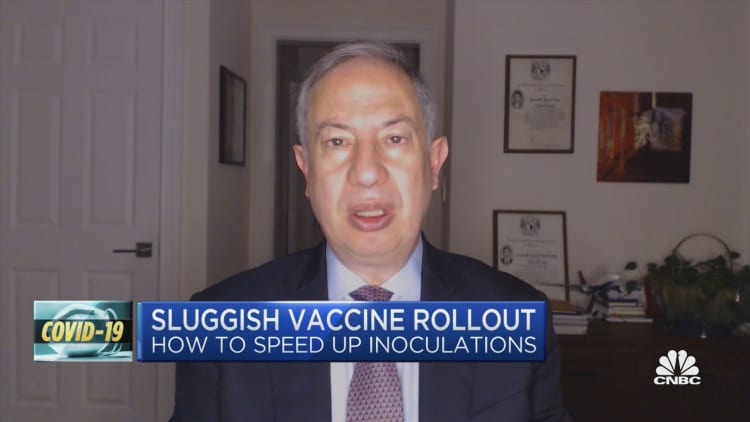
In his first days in office, President-elect Joe Biden plans to sign an executive order to reopen schools.
However, it's not just a matter of federal funding. Vaccinating teachers remains one of the biggest hurdles to returning kids to classrooms.
As Covid-19 cases spike across the country, the Centers for Disease Control and Prevention have prioritized teachers and school staff as "essential workers," making them next in line to get the vaccine. However, "it depends on how many teachers will get vaccinated and by when," said Tricia Neuman, senior vice president of the Kaiser Family Foundation — and that is still a matter of availability and access in each state.
More from Personal Finance:
In-person learning is a luxury months into the pandemic
More colleges plan to reopen for the spring semester
Stimulus relief could include a break for school expenses
As of the most recent tally, 37 out of 51 jurisdictions included this group in Phase 1 of their vaccination plans, according to an analysis of coronavirus vaccination planning from all 50 states and the District of Columbia.
And yet, the initial rollout was slower than expected, as distribution proved more complicated and chaotic in many areas across the country.
In New York state, Gov. Andrew Cuomo recently announced that teachers, police, firefighters, public transit workers and other first responders can now get vaccinated, along with people age 65 or older, making more than 3 million people in the state eligible.
Still, under current federal guidelines, New York state is only allocated 300,000 vaccine doses a week.
"The limits on the state's supply will mean that not everyone who wants the vaccine will be able to get it immediately," said Michael Mulgrew, president of the United Federation of Teachers, New York City's teachers union. New York City, the country's largest school system, has struggled to reopen since shutting down in November due to the city's rising positivity rate.
In some cases, priority will be given to teachers already working in schools.
There's a light at the end of the tunnel.Jamie Saranikkindergarten teacher
Jamie Saranik, 43, received the first dose of the vaccine on Jan. 11. As a kindergarten teacher in the Great Neck public school district on New York's Long Island, Saranik has been teaching in-person since September.
Still, "mentally, something shifted for me," she said of getting vaccinated. "There was definitely a sense that there's a light at the end of the tunnel.
"I won't feel like I need to worry as much if I crouch down to read with a student or zip up a jacket."
"No one wants to return to in-person learning more than the educators who dedicate their lives to helping their students succeed," said Becky Pringle, president of the National Education Association.
Some studies show distance learning is causing a significant setback in educational achievement, particularly among Black and Hispanic students, as well as students with disabilities.
If schools remain remote, the potential loss could be substantial, especially in mathematics — with students likely to lose five to nine months, on average, of learning by the end of this school year, according to a recent study by McKinsey & Company.
The report found that about 60% of K-12 students started the school year fully remote, while 20% began with a hybrid model of some in-person classes and some remote. The remaining 20% went back to their classrooms full time.
Students in urban areas and large school districts are most likely to still be learning remotely.
"Some parents who can afford it have switched their children to private schools, pandemic podsor homeschooling," the report said. "Other children lack that option."
New York City Mayor Bill de Blasio said more students will be able to return to classrooms this spring once teachers are vaccinated.


